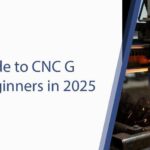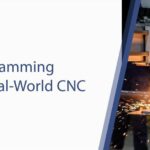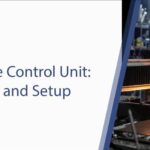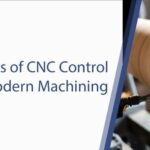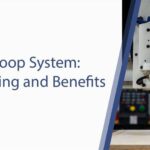CNC and Artificial Intelligence — The Evolution of Smart Manufacturing
Since the dawn of the industrial revolution, manufacturing has evolved through waves of innovation.
Today, the fusion of CNC and AI: (Computer Numerical Control) and Artificial Intelligence (AI) stands as the most transformative phase yet. While CNC ensures precision and automation, AI introduces intelligence, prediction, and adaptability — together driving a new era of smart, data-driven manufacturing.
This integration empowers industries to achieve higher accuracy, faster production cycles, and sustainable efficiency across complex production lines.

Understanding CNC Machines
CNC machines are computer-controlled systems that manufacture parts with exceptional precision and speed. By following digital commands, these machines automate processes like cutting, milling, drilling, and turning, minimizing the need for manual labor. Their introduction in the 1950s revolutionized industrial production by replacing manual machining with programmable automation.
Modern CNC systems now incorporate sensors, servo motors, and robotic arms to deliver high-speed performance and consistent quality. From automotive and aerospace to jewelry and electronics, CNC technology enables scalable, repeatable, and high-quality production that forms the foundation of today’s manufacturing infrastructure.
Limitations of Traditional CNC Machines
Despite their unmatched precision, traditional CNC machines operate on fixed programming logic. They follow exact commands but lack the ability to interpret or learn from their environment. This limits flexibility, slows adaptation, and increases the risk of downtime when unexpected variables — such as material defects or tool wear — occur.
The introduction of Artificial Intelligence bridges this gap. By combining machine learning algorithms, neural networks, and data analytics, AI enables CNC systems to evolve from passive executors into intelligent decision-making units. These upgraded systems can analyze data, predict issues, and adapt to dynamic manufacturing needs, marking a fundamental leap from automation to true intelligence.
The Role of Machine Learning in CNC
Machine Learning (ML), a core branch of AI, gives CNC machines the ability to learn from operational data. Through sensors and cameras, CNC systems capture continuous feedback on speed, torque, tool wear, and precision. ML algorithms process this information to make micro-adjustments — correcting deviations instantly and improving outcomes over time.
CNC machines also generate large volumes of performance data, from cycle times and energy consumption to part tolerances. AI and ML convert this data into actionable insights that production teams can use to optimize quality, resource allocation, and maintenance planning.
This self-learning capability turns CNC operations into evolving systems — consistently refining efficiency and ensuring that each manufacturing run performs better than the last.

Detecting and Preventing Machine Failures
One of AI’s most valuable applications in CNC technology lies in predictive maintenance. Machine failures can halt production unexpectedly, but AI-powered CNC systems detect potential problems long before they cause disruption. By analyzing vibration, heat, and pressure patterns, AI can predict wear, alert technicians, and even trigger automated safety responses.
When integrated with robotics, AI extends this intelligence further. Robots working alongside CNC machines can autonomously handle material loading, part transfer, and precision alignment, reducing human intervention and operational risk. This seamless collaboration creates an agile and reliable production environment where downtime is minimized and productivity remains uninterrupted.
Flexibility and Adaptability in Production Lines
The fusion of AI and CNC automation brings unprecedented flexibility to manufacturing. Production lines powered by AI can adjust in real time — whether it’s reprogramming a robot for a new component or adapting feed rates to material changes. This adaptability enables manufacturers to respond instantly to market shifts, design changes, or fluctuating demand.
The benefits extend beyond speed. AI allows for smarter decision-making in areas such as:
- Dynamic production scheduling that optimizes workflow efficiency.
- Real-time quality monitoring through visual and sensor feedback.
- AI-based design recommendations for improving manufacturability and cost efficiency.
Through these innovations, factories evolve into smart ecosystems capable of customizing products at industrial scale without compromising speed or precision.

AI and the Self-Improving CNC Machine
AI gives CNC systems the ability to self-optimize throughout their lifecycle. By continuously analyzing performance data, an AI-driven CNC machine can learn how to improve its cutting strategy, timing, and tool usage — all without human intervention. This reduces energy consumption, extends machine life, and maintains consistent accuracy across long production runs.
Furthermore, AI supports demand-based forecasting, helping manufacturers predict production needs and adjust resources accordingly. This reduces overstocking, prevents material waste, and ensures that manufacturing output remains aligned with real-time market demand.
With every cycle, CNC machines become more adaptive, efficient, and reliable — defining the next generation of intelligent manufacturing systems.
Next-Generation CNC and AI Integration
The next generation of CNC technology will be deeply intertwined with AI and CAD (Computer-Aided Design) software. AI will assist designers by suggesting design optimizations, identifying potential structural weaknesses, and recommending ideal machining parameters. This collaboration between design and manufacturing ensures that parts are not only functional but also optimized for precision and speed.
In production, integrated AI-driven sensors and cameras will monitor every stage of machining, identifying deviations or defects in real time. This continuous analysis ensures that defective parts are prevented before completion — reducing both waste and cost. The result is a fully connected manufacturing ecosystem where data, design, and production communicate seamlessly for maximum performance.

Conclusion — Radonix and the Future of AI-Powered Manufacturing
The integration of CNC technology and Artificial Intelligence represents a defining moment in industrial progress — and Radonix is at the forefront of this transformation. By uniting precision CNC control with advanced AI systems, Radonix enables factories to become smarter, more sustainable, and more responsive than ever before.
This synergy enhances every layer of production:
- Efficiency through intelligent process optimization.
- Quality through predictive analytics and real-time monitoring.
- Sustainability through energy-efficient and adaptive manufacturing.
As AI continues to evolve, Radonix CNC systems will lead the way in reshaping global manufacturing — turning data into precision and innovation into measurable performance.
Contact Us:
- E-Mail: info@radonix.com
- Phone: +90 (553) 920 5500


